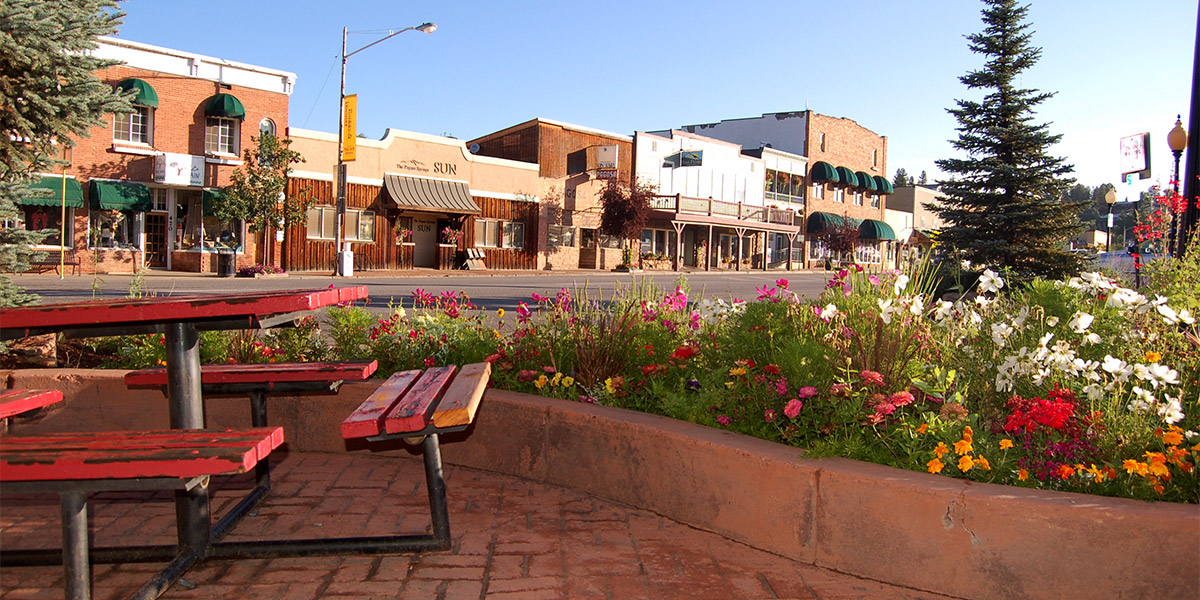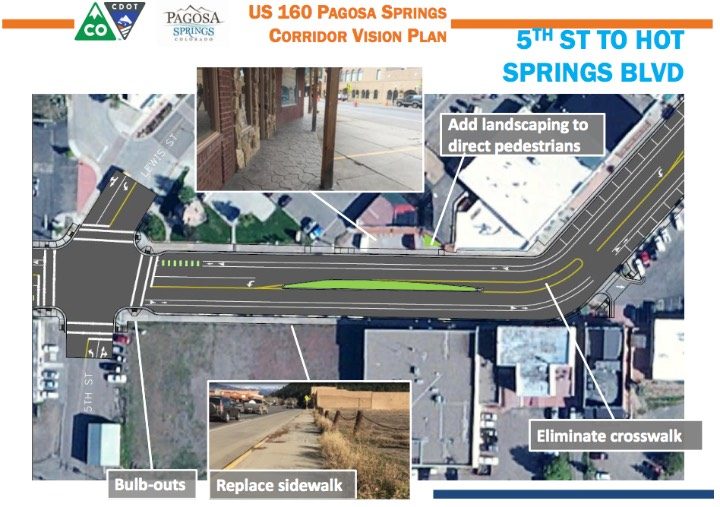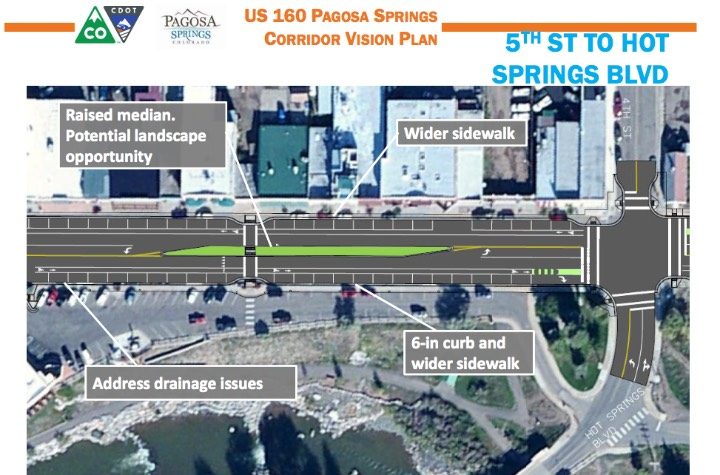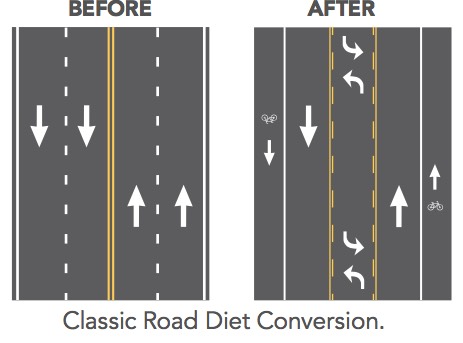“The good news is, you’ve got some projects that made it into the top 15. We’ll talk more with you once we get those top 15 locations prioritized, because we haven’t done that yet…”
— from the February 26 CDOT presentation
As mentioned in Part One, the folks from Colorado Department of Transportation (CDOT) Region 5 gave a joint presentation to the Board of County Commissioners and the Town Council on February 26, to introduce their latest ideas for the improvement of Highway 160 as it barrels its way through Pagosa Springs.
The expensive part of the plan involves a new bridge where McCabe Creek flows under the highway near South 6th Street
Most of our readers have no doubt driven Highway 160, and the lucky ones have never crashed their vehicle, nor been crashed into. I can’t say for certain, but I imagine that tourists — unfamiliar with Colorado driving habits and the quirky design of certain intersections — probably account for a disproportionate share of crashes.
CDOT has been experiencing a funding shortage for a number of years now, in terms of the projects they wish they could complete compared to the tax revenue shared with the department by the Colorado General Assembly. (See Part One for more details.) The Region 5 folks who presented on February 26 explained that 72 projects had been identified during their recent ‘Critical Locations Study.’ They believe they will be able to fund 15 of those projects.
Maybe? Someday?
CDOT has various pots of money earmarked for various types of improvements and maintenance. Some of the least expensive safety projects involve adjustments to signal timing, and to revising the lane striping. Listening to the February 26 presentation, I got the impression that these ‘affordable’ safety enhancements might take place within the next year.
Here are the crash stats, as presented last week, for the Pagosa projects that qualified for serious consideration:
Piedra Road Intersection
Proposed to be re-striped. 76 percent of crashes are ‘rear end.’ 55 percent of drivers at fault were west-bound.
Pagosa Boulevard Intersection
Adjust signal timing. Majority of crashes are from vehicles making left turn, east-bound.
Pinon Causeway
Adjust signal timing. Majority of crashes are vehicles heading west-bound. 83 percent of crashes are ‘rear end.’
Downtown Pagosa Springs
Road Diet. 43 percent of crashes are ‘rear end.’
More about ‘Road Diets’ in a moment…
According to the National Highway Traffic Safety Administration, rear-end collisions are the type of crashes that occur the most frequently — responsible for about 29 percent of all car accidents nationwide. About 81 percent of rear-end accidents occurred during daytime hours on dry, straight and level roads, when the lead vehicle was completely stopped. In most collisions, the driver was following too closely to the car in front of it, and was typically distracted or not paying attention.
Male drivers between the ages of 25 and 34 were twice as likely to be involved in a rear-end collision. Not paying attention, boys?
As mentioned, these re-striping and signal adjustments can be funded out of CDOT’s ‘safety’ funding. The more expensive stuff — like the proposal to construct a new McCabe Creek bridge, and the related proposal to replace the failing asphalt through downtown Pagosa with a new concrete surface — has a vaguely defined price tag of $10 million or so.
Maybe four years out? I think I heard someone, quietly, mention “four or five years.”
That downtown project, if it ever gets funded, would conceivably add two new medians within Pagosa’s two-block commercial core. And bike lanes.
One median would be in front of the historic Courthouse.
The other median would be in front of our main retail block, where there’s a mid-block pedestrian crossing.
We were told that the presence of medians in the middle of a roadway causes traffic to slow down, and can provide pedestrians trying to cross the street with a mid-street refuge. We were also told that medians present a problem with snow removal. Guess CDOT has to weigh the pros and cons.
Other ways to slow traffic: add bike lanes on both sides of the roadway, and reduce the number of vehicle lanes from four down to two (usually with a center turn lane or median.) This is sometimes referred to as a Road Diet. A study conducted by the Federal Highway Administration (FHWA) found that four-lane to three-lane Road Diet conversions reduce the total number of crashes by 19 to 47 percent.
CDOT Region 5 put the east end of downtown on a Road Diet three years ago, and striped bike lanes through that end of town. I live downtown, and drive that section of 160 on a regular basis. Over the past three years, I think I’ve seen a total of two bicycles use the bike lanes. But a transportation department can qualify for special federal funding if they’re adding bike lanes to a highway… even in a retirement community like Pagosa Springs, where hardly anyone rides a bike.
Someday, we may have a Road Diet through the rest of downtown.
Here’s former Region 5 director Mike McVaugh, back in 2017, talking about CDOT debt. This was before Colorado voters rejected two ballot measures to create even more debt for highway maintenance.
“We have a limited amount of funding. This last year, there was a lot of discussion about whether there would be a referendum at the state legislative level, to be on this November’s ballot…
“So they kind of finished up the year, last year, with Senate Bill 267. And SB 267 is a unique animal, where it’s allowing CDOT to go out to bonding for $1.88 billion. And the there’s some other money in there for transit. So it’s $1.88 billion over a four-year period. And it’s using buildings as equity, that the state owns, to do COPs (Certificates of Participation) essentially.”
Using buildings as equity. $1.88 billion in new CDOT debt, via COPs. The state of Colorado feels like we can’t afford to maintain our main highways within its total annual state budget of $31 billion, so we’ve essentially handed our government buildings over the private ownership, via COPs, to fund about 25 percent of the 2018-2019 CDOT budget.
What happens in four years, when the highway maintenance needs to continue — but we’ve already put every government building in hock for 20 years? Is there any way to extract ourselves from this growing government debt?
Lately, we are watching our local governments create COP debt. The Town Council is planning to use COPs to fund a new $5 million Town Maintenance complex. The County is planning to use COPs to fund a $13 million Detention Center. Both of these decisions will create long-term debt, without any extra funding to pay for the debt payments.
My grandchildren will still be paying for our 2019 debts, when they graduate from college. I hate to imagine what the highways will look like then.




